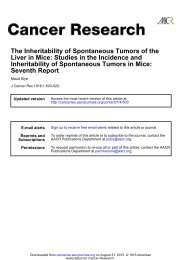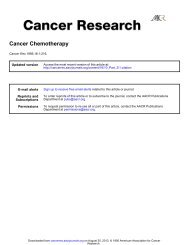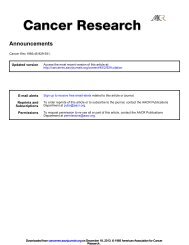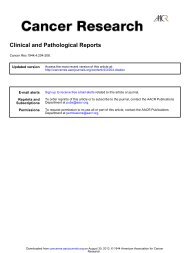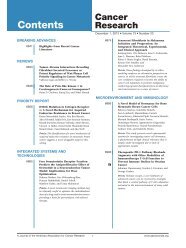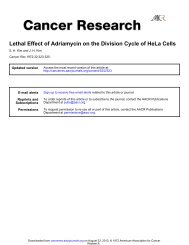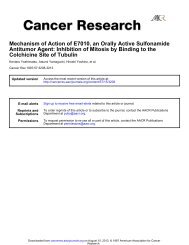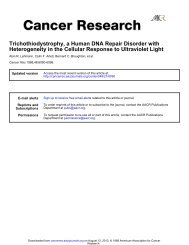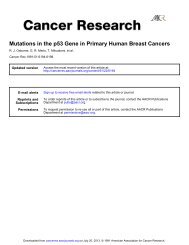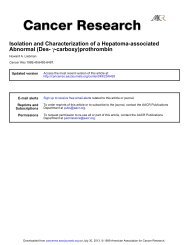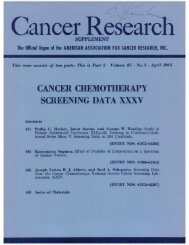Selective Effects by Valinomycin on Cytotoxicity ... - Cancer Research
Selective Effects by Valinomycin on Cytotoxicity ... - Cancer Research
Selective Effects by Valinomycin on Cytotoxicity ... - Cancer Research
Create successful ePaper yourself
Turn your PDF publications into a flip-book with our unique Google optimized e-Paper software.
procedures for seeding and Coulter counting of the experimental cultures<br />
were as described previously (23), yielding cell densities of parallel plates<br />
reproducible within 5 to 10%. All the data given are averages from<br />
duplicate plates. VAL was obtained from Serva, Heidelberg, Federal<br />
Republic of Germany, and was applied from a 20 ,UMstock soluti<strong>on</strong> in<br />
ethanol, keeping the ethanol c<strong>on</strong>centrati<strong>on</strong> in the medium below 0.1%.<br />
C<strong>on</strong>trols were treated equally, but without VAL.<br />
Cell Cycle Analysis. Fracti<strong>on</strong>s of cells in different phases of the cell<br />
cycle were determined flow cytometrically <str<strong>on</strong>g>by</str<strong>on</strong>g> the fluorescence of the<br />
DNA-specific bisbenzimide stain Hoechst 33258, using the impulse cy-<br />
tophotometer ICP22 (Biophysics Systems, Bensheim, Federal Republic<br />
of Germany) as described previously (23). Cells were trypsinized, fixed<br />
for 15 min in 50% ethanol, and stained for 10 min in Hoechst 33258 (8<br />
¿ig/ml).The DNA histogram was evaluated graphically in terms of the<br />
relative fracti<strong>on</strong> GiM of cells with a Gìequivalent of DNA, defined as the<br />
ratio of the area of the Gìpeak to the total area of the fluorescence<br />
histogram. For separati<strong>on</strong> of the area of the d peak in the regi<strong>on</strong> of<br />
overlap with the S-phase area of the histogram, the criteria given in (24)<br />
were applied, allowing, if necessary, for skewed S-phase distributi<strong>on</strong>s<br />
<str<strong>on</strong>g>by</str<strong>on</strong>g> n<strong>on</strong>horiz<strong>on</strong>tal extrapolati<strong>on</strong> of the S-phase area up to the abscissa of<br />
the G! maximum.<br />
Determinati<strong>on</strong> of Cellular ATP. Cellular levels of ATP were deter<br />
mined <str<strong>on</strong>g>by</str<strong>on</strong>g> the luciferin-luciferase assay. Cells were scraped off the plate<br />
with a rubber policeman and suspended in 5 ml calcium-magnesium-free<br />
phosphate-buffered saline c<strong>on</strong>taining 1 mw EDTA. A volume of 0.1 to<br />
0.2 ml of this cell suspensi<strong>on</strong> was added to 0.6 ml of distilled boiling<br />
water and heated for 10 min in a boiling water bath. Cellular ATP was<br />
measured in a luminometer (Luminometer 1250; LKB, Gräfelfing,Federal<br />
Republic of Germany) after adding a 10- to 1OÛ-M!aliquot of this soluti<strong>on</strong><br />
to a volume of 200 n\ reagent soluti<strong>on</strong> of the luciferin-luciferase system<br />
(ATP Bioluminescence CLS; Boehringer, Mannheim, Federal Republic of<br />
Germany). Measurements were calibrated <str<strong>on</strong>g>by</str<strong>on</strong>g> adding 5 ^l of a standard<br />
with known ATP c<strong>on</strong>centrati<strong>on</strong>.<br />
RESULTS<br />
Effect of VAL <strong>on</strong> Proliferati<strong>on</strong> and Viability. The effect of<br />
VAL <strong>on</strong> the proliferati<strong>on</strong> and viability of different normal and<br />
transformed cell lines is shown in Charts 1 to 9. In all these<br />
experiments, cells were seeded at a density of 1000 to 3000/sq<br />
Chart 1. Effect of VAL <strong>on</strong> proliferati<strong>on</strong> and viability of 3T3 cells maintainedwith<br />
daily medium renewals c<strong>on</strong>taining NBCS. O, untreated c<strong>on</strong>trol (5% NBCS);•, cells<br />
during daily applicati<strong>on</strong> of 20 nw VAL (5% NBCS); A, cells after VAL treatment,<br />
maintainedwith 5% NBCS; A, same with 20% NBCS; •cells after VAL treatment<br />
reseeded at 5% NBCS. Top, density of cells adhering to the plates; bottom,<br />
percentage of cells released into the supernatant medium since the last renewal<br />
relative to the number of adhering cells; abscissa, time of growth in days (t/d).<br />
GROWTH INHIBITION AND CYTOTOXICITY BY VAL<br />
CANCER RESEARCH VOL 45 JULY 1985<br />
3023<br />
Chart 2. Effect of VAL <strong>on</strong> proliferati<strong>on</strong>and viabilityof SV40-3T3cells maintained<br />
with daily medium renewals c<strong>on</strong>taining NBCS. O, untreated c<strong>on</strong>trols (5% NBCS);<br />
».cells during daily applicati<strong>on</strong> of 20 ni«VAL (5% NBCS); A, cells after VAL<br />
treatment maintainedwith 5% NBCS; A, same at 20% NBCS; •cells after VAL<br />
treatment reseeded at 5% NBCS. Top, density of cells adhering to the plates;<br />
bottom, percentage of cells released into the supernatant medium since the last<br />
renewal relative to the number of adhering cells; abscissa, time of growth in days<br />
(t/d).<br />
cm in Dulbecco's modificati<strong>on</strong> of Eagle's medium c<strong>on</strong>taining 5%<br />
NBCS and maintained with daily medium renewals. From the<br />
time indicated <str<strong>on</strong>g>by</str<strong>on</strong>g> the first arrow until the time indicated <str<strong>on</strong>g>by</str<strong>on</strong>g> a<br />
sec<strong>on</strong>d arrow (whenever this occurs), VAL was applied daily at<br />
20 nw (except in the experiments shown <strong>on</strong> Charts 3, 7, and 8,<br />
where variant c<strong>on</strong>centrati<strong>on</strong>s of VAL were used). In all cases,<br />
proliferati<strong>on</strong> of the treated populati<strong>on</strong>s is completely arrested<br />
after about 2 days of severely slowed-down growth. Even at a<br />
c<strong>on</strong>centrati<strong>on</strong> as low as 2 nw, there is substantial inhibiti<strong>on</strong> of<br />
proliferati<strong>on</strong> as shown in Chart 7 for 3T6 cells (similar data were<br />
obtained for 3T3 and SV40-3T3 cells, not shown).<br />
Toxic effects of VAL <strong>on</strong> the cell lines investigated are indicated<br />
<str<strong>on</strong>g>by</str<strong>on</strong>g> decreases of cell densities with time. In additi<strong>on</strong>, we have<br />
determined <str<strong>on</strong>g>by</str<strong>on</strong>g> Coulter counter the number of cells per nuclei<br />
released into the medium during the 1-day interval since the last<br />
medium exchange. These data are plotted in the lower parts of<br />
Charts 1 to 4 as a percentage of cells in the supernatant medium<br />
relative to adhering cells, and they agree well with corresp<strong>on</strong>ding<br />
decreases of numbers of (adhering) cells given in the upper parts<br />
of these charts. At 20 to 100 nv VAL, there is little effect <strong>on</strong> the<br />
viability of 3T3, 3T6, and Rat-1 cells (Charts 1, 3, 5, 7, and 8).<br />
Inhibiti<strong>on</strong> of proliferati<strong>on</strong> <str<strong>on</strong>g>by</str<strong>on</strong>g> VAL in these cells is reversible after<br />
a certain time lag, as shown <str<strong>on</strong>g>by</str<strong>on</strong>g> disc<strong>on</strong>tinuing the VAL treatment<br />
after 3 days and applying fresh medium c<strong>on</strong>taining 5% or 20%<br />
NBCS with daily medium renewal (Charts 1 and 3). The lag time<br />
of recovery of proliferati<strong>on</strong> is somewhat shorter, when cells are<br />
trypsinized and reseeded at lower cell density into fresh medium<br />
c<strong>on</strong>taining 5% NBCS (Charts 1 and 3). Essentially all of the cells<br />
n<strong>on</strong>toxically exposed to VAL will resume proliferati<strong>on</strong> after 2-5<br />
Downloaded from<br />
cancerres.aacrjournals.org <strong>on</strong> December 2, 2012<br />
Copyright © 1985 American Associati<strong>on</strong> for <strong>Cancer</strong> <strong>Research</strong>




